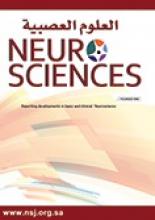Article Information
PubMed
Published By
Online ISSN
History
- Received June 24, 2022
- Accepted August 2, 2022
- Published online October 17, 2022.
Copyright & Usage
Copyright: © Neurosciences Neurosciences is an Open Access journal and articles published are distributed under the terms of the Creative Commons Attribution-NonCommercial License (CC BY-NC). Readers may copy, distribute, and display the work for non-commercial purposes with the proper citation of the original work.
Author Information
- Mohammed A. Aljaffer, MBBS, MD,
- Ahmad H. Almadani, MBBS, FRCPC⇑,
- Saleh A. Alghamdi, MBBS, MD,
- Ibrahim M. Alabdulkarim, MBBS,
- Mohammed A. Albabtain, MBBS,
- Rayed M. Altameem, MBBS,
- Abdulrahman A. Almugren, MBBS,
- Abdulaziz F. Alomairy, MBBS and
- Abdulaziz A. Alghofaily, MBBS
- From the Department of Psychiatry (Aljaffer, Almadani), College of Medicine, King Saud University, from the College of Medicine (Alabdulkarim, Albabtain, Altameem, Almugren, Alomairy, Alghofaily), King Saud University, and from the Clinical Neurosciences Department (Alghamdi), College of Medicine, Imam Mohammad Ibn Saud Islamic University, Riyadh, Kingdom of Saudi Arabia
- Address correspondence and reprint request to: Dr. Ahmad H. Almadani, Department of Psychiatry, College of Medicine, King Saud University, Riyadh, Kingdom of Saudi Arabia. E-mail: ahalmadani{at}ksu.edu.sa ORCID ID: https://orcid.org/0000-0003-4490-3220






